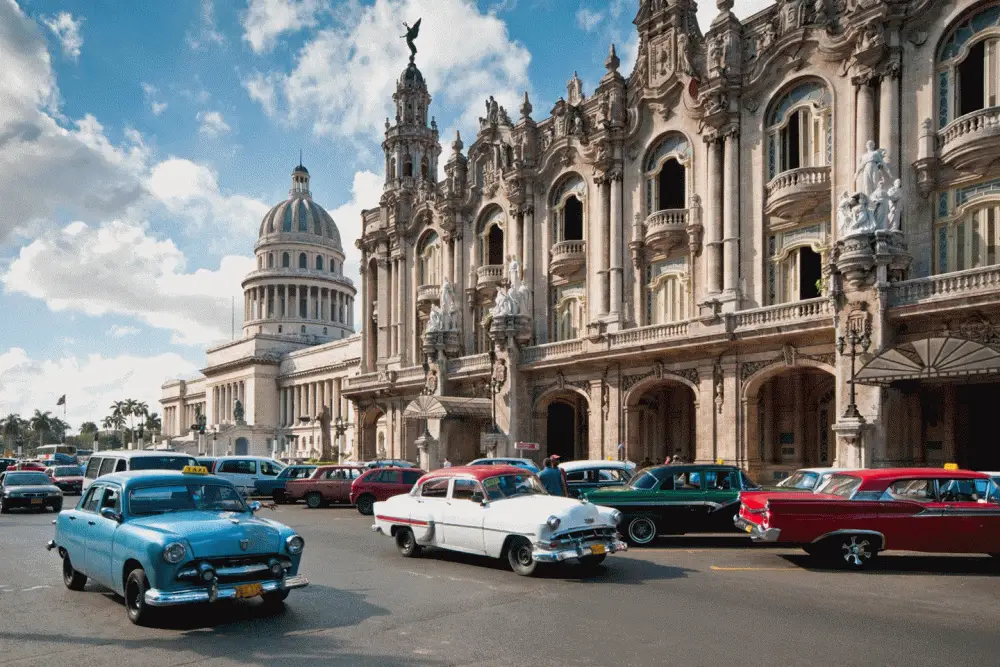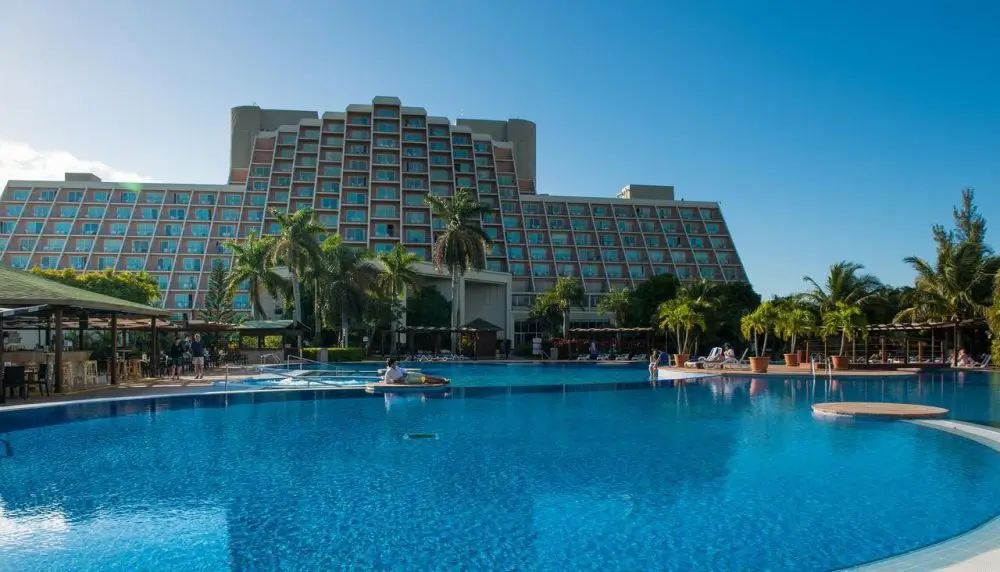Havana maintains a unique balance between old architecture, colonial charm and the vibrant atmosphere of a Caribbean resort. Cuba’s capital offers not just a holiday, but a journey through time. Each neighbourhood reveals a different facet of the country’s history, culture and gastronomy. To see the city without rushing and truly feel its spirit, you should determine in advance which interesting places in Havana are worth including in your itinerary.
Old Havana: the heart of historical heritage
The historic centre is a UNESCO World Heritage Site for its unique blend of Spanish colonial style and Cuban identity. The narrow streets, colourful facades and squares offer tourists a gallery of living history.

De Armas Square
 De Armas Square is a collection of architectural monuments from the 16th to 18th centuries. Baroque buildings are juxtaposed with museums and bookshops, creating an old-world atmosphere. Tourism in Havana almost always includes a visit to this corner – most sightseeing tours start here.
De Armas Square is a collection of architectural monuments from the 16th to 18th centuries. Baroque buildings are juxtaposed with museums and bookshops, creating an old-world atmosphere. Tourism in Havana almost always includes a visit to this corner – most sightseeing tours start here.
Cathedral Square
The Cathedral Square surrounds the main church of the city – St Christopher’s Cathedral. The building impresses not only with its architectural details, but also with its spiritual atmosphere. It is here that Cuban culture manifests itself in its entirety: music, painting, and theatre often accompany local festivals.

Piazza Vieja
Vieja Square has a lively atmosphere. It is home to cafés, art galleries and souvenir shops. Restored houses from different eras turn the square into an open-air museum. What to see in Havana if you want to feel the vibrant pulse of the city, Vieja Square is the place to be.
Malecon promenade: a symbol of romance
The Malecon promenade stretches along the coast for almost 8 kilometres. This is where locals gather in the evenings to watch the sunset, listen to music and enjoy the freshness of the ocean breeze. Havana’s places of interest include the Malecon as a must-see. Along the promenade are early 20th century Art Nouveau and Art Deco buildings. Many of them have been damaged by time, but this is what creates a unique flavour. Tourists often stop at the quay for photos and to socialise with local fishermen.
Havana’s Capitol: one of the most interesting places to visit
The Capitol impresses with its size and architectural opulence. This building, reminiscent of its American counterpart in Washington, D.C., has long served as the seat of parliament. Now it houses the Academy of Sciences and the State Library. A visit to the Capitol is one answer to the question of what to see in Havana. The interiors are decorated with marble and stained glass, and at the main entrance stands the Statue of the Republic, the largest sculpture under a roof in the world.
Hemingway’s footprints: museum and legends
Literature lovers must include the Hemingway Museum, located in the writer’s former residence, Finca Vihija. Here you can see the furnishings from the times of the life of the author of “The Old Man and the Sea”, from his personal library to hunting trophies. Havana’s interesting places are so firmly linked to Hemingway’s name that many bars, such as Floridita and Bodeguita del Medio, boast plaques with quotes from the writer. Tours in his footsteps allow you to see the city through the eyes of the Nobel laureate.
Culture and traditions of the most interesting places in Havana
The region lives and breathes culture. The city turns every street into a stage, every courtyard into a small theatre. Interesting places in Havana always include not only sights, but also moments of everyday life, where the real Cuba is unvarnished.
The August Carnival on the Malecon promenade gathers hundreds of participants in colourful costumes. Festival columns with musicians, dancers and decorations in the style of Afro-Cuban folklore move along the ocean, turning the coast into a living river of energy. The sounds of conga, rumba and salsa fill the space. The music created before your eyes embraces passers-by, engaging them in an improvised dance. The carnival lasts for days and nights, forming one of the most colourful pages in Cuba’s events calendar.
Street musicians are a separate layer of Havana’s cultural life. Small ensembles play son, bolero, guajira and salsa at every turn: at cafes, at the columns of ancient buildings, on park benches. Every chord sounds sincere, turning an ordinary walk into a real journey into the musical soul of the country.
Folk artisans fill the streets of Old Havana with handmade products. Wooden sculptures, painted ceramic tiles, textiles with traditional patterns and tobacco products become living witnesses of centuries-old traditions. Havana tourism, steeped in street culture, allows you to not only see but also touch the very real spirit of the island.
Pedestrians easily become part of this lively spectacle. Even an ordinary seat on a bench can turn into a spontaneous participation in a salsa lesson or an invitation to a party in a neighbouring courtyard. This direct openness is what makes Havana’s street life unique.
Cuban realities: what a tourist needs to know
Travelling to Havana requires an understanding of the peculiarities of the local reality. Cuba remains a country with unique rules and traditions that shape the daily life and behaviour of visitors. There is a dual currency system in place. The local currency CUP is used for settlements between residents, while the MLC currency is used for payments in shops for tourists. When planning your budget, it is worth taking into account the need to convert currency at special exchange offices or banks.
When travelling around the city, it is important to have your passport or a photocopy of it. Cuba strictly enforces visa controls and police often check documents on the street, especially in tourist areas. Taking photographs of government buildings, military installations and police is prohibited. Violation of this rule can lead to unpleasant consequences up to administrative responsibility. However, there are no restrictions for personal photos of places of interest.
Interesting places such as Old Havana, the Malecon promenade or museums are guarded by the tourist police, which ensures a high level of security. Crime against foreigners remains low due to strict controls. The cost of living in Havana remains democratic. Taxis within the city cost around $8-12 per trip. Dinner in a typical Cuban restaurant costs an average of $5-8 per person. Accommodation in private mini-hotels – from 20 to 40 dollars per night.
The transport system is represented by buses, shuttle buses and private taxis. Although public transport is cheap, the quality of service can vary, especially during peak hours. Cuba respects tradition and emphasises politeness. A smile, a greeting and a calm tone in conversation opens many doors. Tourism in Havana requires travellers to be prepared for a leisurely pace of life, where time flows more slowly than in metropolises.
Choose the most interesting places in Havana to have a great time
 Havana unfolds slowly, like a well-aged rum. Travelling through its streets becomes a real adventure, where every turn leads to a new discovery. From quiet squares to bustling promenades, from ancient temples to modern art galleries, Havana’s interesting places are astonishingly diverse. To truly feel the rhythm of Cuba’s capital, you should let yourself get lost in its magic.
Havana unfolds slowly, like a well-aged rum. Travelling through its streets becomes a real adventure, where every turn leads to a new discovery. From quiet squares to bustling promenades, from ancient temples to modern art galleries, Havana’s interesting places are astonishingly diverse. To truly feel the rhythm of Cuba’s capital, you should let yourself get lost in its magic.
 en
en  ar
ar  de
de  es
es  fr
fr  nl
nl  hi
hi  it
it  pt
pt  el
el 



